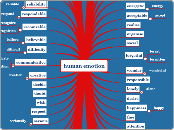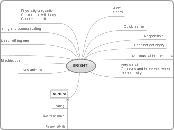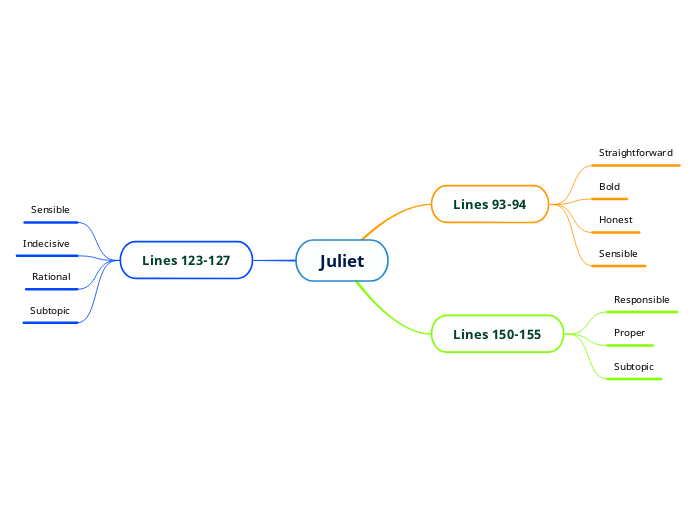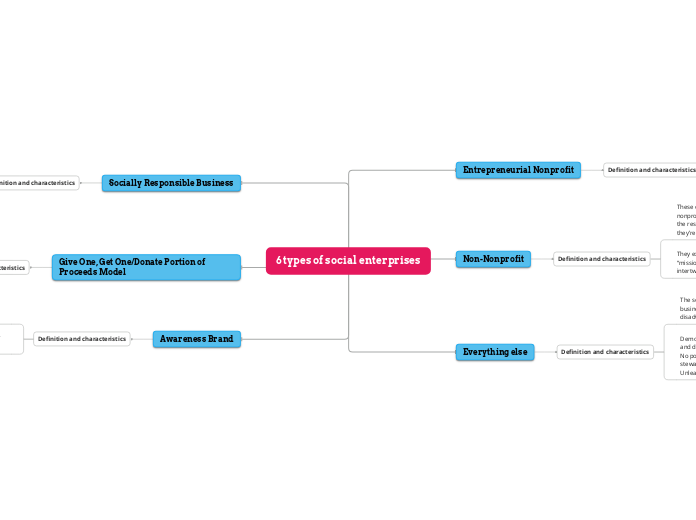Responsible Mind maps - offentligt galleri
Udforsk vores store offentlige samling af responsible-mind maps skabt af Mindomo-brugere over hele verden. Her kan du finde alle offentlige diagrammer, der er relateret til responsible. Du kan se disse eksempler for at få inspiration. Nogle diagrammer giver dig også ret til at kopiere og redigere dem. Denne fleksibilitet giver dig mulighed for at bruge disse mind maps som skabeloner, hvilket sparer tid og giver dig et stærkt udgangspunkt for dit arbejde. Du kan bidrage til dette galleri med dine egne diagrammer, når du har gjort dem offentlige, og du kan være en inspirationskilde for andre brugere og blive omtalt her.


General vocabulary word
af Samuel Anderson-McCoy


Srishti
af Shibumi (School)


once now
af Norma Montes


Celebrating cultural diversity
af Mindomo Team


Gayu
af Shibumi (School)


RICARDO ANDRES
af ricardo andres


MY PERSONALITY
af ALIRIS JULIETH CASELLES CHARRIS


THE FOOTBALL-MARIA FERNANDA ALZATE
af Mafe Alzate


santiago_sierra@javeriana.edu.co
af Santiago Sierra


Juliet
af David A Olea


MARIO BENEDETTI
af AGATA A.


Brie How might I become a more powerful person?
af Laidman Brie


isabel sofia quintero londo
af Isabel Sofia Quintero


Successful Techology Class
af Adam Berger


Educated Citizen
af Barron Harris


1. Entrepreneurial Nonprofit These are tax-exempt entities supported, at least in part, by earned income (although I’ve seen it argued once or twice that an innovative nonprofit idea, even without earned income, makes the cut). To reach entrepreneurial nonprofit status, these organizations can either (a) implement a revenue-generating program or (b) adopt an overall entrepreneurial business model. Funding Their main funding sources typically are grants from foundations and donations from the general public (the cornerstone of the tax-exempt nonprofit model), although in some circumstances loans from banks, or from foundations in the form of program-related investments, are also possible. Examples Girl Scouts of America, with its much-loved cookie sale program, and Daily Table and With Love L.A., retail grocers bringing healthy, affordable food options to neighborhoods that don’t otherwise have access. 2. Non-Nonprofit Never heard of this one? I’m not surprised — I made it up, for the sake of clarifying often-overlooked yet meaningful distinctions. These organizations start with social mission, much like a nonprofit, and then figure out a way to make it work outside the restrictions of a tax-exempt model — in other words, they’re a for-profit business. They exist primarily to address a social issue (“mission-first” or “mission-centric”), with revenue-generating activities intertwined with change-making activities. They don’t form as for-profits because they are in business “for profit”; rather, it’s a decision that allows for higher-capacity growth, sustainability, innovation and risk-taking — all components of highly successful entities in other sectors — than is generally permitted under the regulations that come with tax-exemption. Funding The ideal funding source here is program-related investments from foundations, which provide low-cost capital at a critical early stage and prevent compromising the fullest expression of mission for financial returns down the road. In some cases, grants from foundations or investments from traditional angel investors or venture capital firms also may be possible. Examples Everytable, seeking to eliminate food deserts through affordable grab-and-go meals with a first-of-its-kind sliding scale model; and InvestED, opening access to capital to low-income entrepreneurs globally with a creative combination of edtech and fintech. Others that fall in this category include Generation Genius, Amplio Recruiting, Nightingale Apps, Tickleberry Place, Mini City and Neopenda. 3. Socially Responsible Business This is the biggest bucket of them all and includes benefit corporations, Certified B Corporations, and all things double- and triple-bottom-line. While these types of entities can be created primarily to address a social issue, it’s more common that this categorical distinction is based on the adoption of practices benefiting community, employees or environment (generally more aligned with the idea of doing business better). In the case of benefit corporations and B Corps, this distinction is included in the company’s formational documents, along with a provision stating that they are legally permitted to honor this distinction (whether that be company culture, responsible sourcing, etc.), even at the expense of shareholder profit maximization. Worth noting here is that benefit corporations are a legal entity formed at the state level, whereas B Corp is a certification available to other for-profit entities (such as corporations and LLCs). Double-bottom-line denotes a focus on social returns alongside financial ones, while triple-bottom-line denotes a focus on environmental, social and financial returns. Funding Primary funding options here include traditional angel investments and venture capital, as well as program-related investments in some circumstances. Examples THRIVE Farmers Coffee, on the more mission-centric side; Ben & Jerry’s and Patagonia, on the more build-a-better-business side. 4. Give One, Get One/Donate Portion of Proceeds Model These companies direct some portion of their business toward charitable work and are almost always layered into the preceding and subsequent categories (falling on either side of it in the diagram above). Revenue-generating activities are generally wholly separate from change-making activities and, in many cases, the social component is an add-on to the company’s core business. Because these models generally feed back into traditional nonprofit system, I break it out as a separate subcategory. Funding Same as above Examples TOMS, Warby Parker, Good Spread, Newman’s Own. 5. Awareness Brand While some will expand these terms to include virtually everything in the previous two categories, we think they also capture a different type of company not yet mentioned — those that sell products designed to engage community and bring awareness to a social issue, but whose primary activities don’t necessarily address the root cause of the social problem they’re bringing awareness to. Funding Same as above Examples Beautiful in Every Shade, So Worth Loving. 6. Everything Else There is no one-size-fits-all, and not every entity will fit neatly in these categories (particularly given the constantly evolving nature of this sector). The social enterprise employment model, which uses the business to provide meaningful work and empowerment to a disadvantaged population (like Bitty and Beau’s Coffee), is a component that can be layered into any of the categories discussed above Then there are outliers like Fruitcraft (formerly the California Fruit Wine Company), which is pioneering a new model called social value enterprise (SVE). While an untrained eye might classify this as a socially responsible business (group 3 above), the folks behind Fruitcraft are very clear about striving for more — namely using market forces to incentivize and reward thinking about the whole — with three defining aspects they claim put SVE in a category of its own: Democratic ownership by employees, including accountability and decision making within the company. No possibility of sale, keeping the company permanently stewarded by the workforce for the benefit of society. Unleashing 100% of profits for social good.
af lucciano alcaraz



